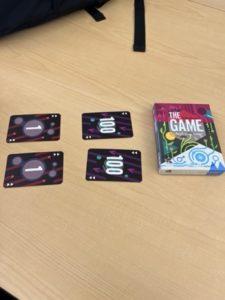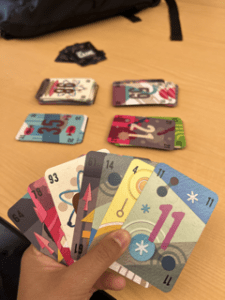What I enjoyed about The Game is that the objective is deceivingly simple. Also, that fact that you can’t just google “The Game” and expect to find it right away.
Mechanics

One starts by placing down four cards: two ascending cards that start from 1 and two descending cards that start from 100. In the deck, there are cards labeled from 2 to 99. The objective is to exhaust the deck by placing increasing cards in the ascending decks and decreasing cards in the descending deck. You can play this with up to 4 friends or all by yourself. Surprisingly, in my opinion, the fun and interest don’t decrease too much when you play it by yourself. Fun may come from fellowship but it doesn’t have to.
You may be thinking: “Piling numbers? Counting? Easy!” It’s much harder to exhaust the deck when other players make moves that disturb your chances to play your cards. For example, if I want to play 99 in the descending deck and the player before me places 80, I can no longer play my card. The designers added what they call “The Backwards Trick” to reverse the deck by putting a card that’s exactly 10 higher (ascending deck) or 10 lower (descending deck). In my previous example, if I had a 90 (10 higher than 80) I can place it in the descending deck essentially reversing all the other plays. I’m not sure how this would affect how challenging it is, but I honestly think it would augment the game if there were more options or tricks to reverse the deck.

It can be a bit difficult to make clever plays when one doesn’t have cards that are 10 apart from each other in their hand. A possible way of abusing the game is keeping cards in your hand that have the same last digit (e.g. all cards with 5 as the last digit). However, this may sabotage other players by ignoring which piles are important to them, which may ultimately hurt the game. I bet you’ll have a lot of extra cards at the end that didn’t make it into the piles. Other than that, there doesn’t seem to be a lot of ways to abuse the system as you want to make the best decisions for your teammates. Your loss is their loss.
Theme & Design
The Game has a fascinating theme that can be seen through the design of the cards. Scientific, abstract, colorful, nature-like symbols cover the deck. For the 10’s, 20’s, 30’s, etc., there is a common design to possibly group the cards more easily. I observed that you know when a deck is doing well when you are able to increment the card numbers slowly, i.e. the cards have the same color and design. This may help players navigate the challenge of The Game a bit easier.
I found the graphics — designed by Kwanchai Moriya — to be quite aesthetic. Although the graphics don’t have a strong connection to the objective of The Game, I found the gameplay to be very visually appealing. I would be arguably say there is a bit of sense-pleasure. The Game resembles the game Tranquility a little bit as they are both cooperative and meditative games that have artistic components to the game design. However, the instructions of The Game are not as complex and there is more room to discover different strategies.
All in all, I enjoyed the abstract theme as seen on the cards; being able to go from single player to multiplayer; how simple the setup and instructions were; and the surprising complexity of The Game.




